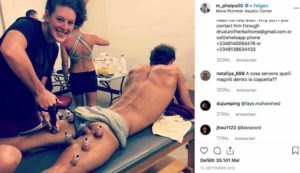Buy cupping glasses: Cupping glasses have been around for many years and are supposed to help improve some body problems.
Buy cupping glasses: What is cupping?
Inhalt
Cupping is a therapy for the skin that has been known for thousands of years, in which special cups are placed on the skin for a few minutes and then a negative pressure is generated. Cupping has many purposes, among others to support pain, inflammation, blood circulation or as a kind of deep massage. Cupping glasses are made of different materials, for example:
- Glass
- Bamboo
- Stoneware
- silicone / plastic (new)
That’s how it looks then:

After insertion, the cups are usually left on the skin for 5 to 15 minutes, leaving bruises or discolorations that can last from several days to a week or longer.
There are different types of cupping therapy:
- When dry cupping a light suction is used, usually with a manual or electronic air pump. Today this is the most common type of cupping therapy.
- In fire cupping, a flame is held in the cups immediately before they are placed on the skin. When the hot air cools, it contracts and pulls the skin into the cup. Classically, the negative pressure in the cupping glass was created by fire.
- Wet cupping, also known as “hijama”, is an old form of cupping in which small incisions are made in the skin before the cupping heads are attached so that blood can be drawn out of the cups and into them.
However, today’s rubber-based attachments make cupping glasses easier to use and can be used quickly with suction pumps, making dry cupping more important.
Cupping therapy has received a lot of attention in recent years, but it has already been developed, but it is not new.  One of the oldest medical textbooks in the world that describes Papyrus “Ebers” from 1500 BC that cupping therapy was used in Egypt. A picture of it on the right: (Source: https://buddhatherapies.com/style/egyptian3.jpg) In the Asian circle cupping is also called Hijama.
One of the oldest medical textbooks in the world that describes Papyrus “Ebers” from 1500 BC that cupping therapy was used in Egypt. A picture of it on the right: (Source: https://buddhatherapies.com/style/egyptian3.jpg) In the Asian circle cupping is also called Hijama.
Cupping became known, for example, in the 2016 Olympics, when Michael Phelps visibly had several cupping sites on his body. Source: Michael Phelps Instagram.
The New York Times observese:
Physiologically, cupping is believed to draw blood into the affected area, reduce pain, and accelerate healing of overworked muscles. Athletes who use it swear that it keeps them free of injury and speeds recovery.
Wet cupping procedure
The procedure for wet cupping is roughly the following:
- Cupping glasses are placed on the skin
- The air is drawn off with a pump to create a mild vacuum.
- The glass is removed after approx. 3 minutes. With a small scalpel you then make light, tiny cuts on the skin.
- After this, the cup is returned to its original position and a small amount of blood is drawn at a second suck.
Here’s a report on it:
Cupping: Method at a glance
Cupping is based on the assumption that there is a connection between pain and congestion.
An old Chinese medical maxim says: Where there are congestions, there will be pain.
So whoever removes the congestion also removes the pain. Many diseases come from stagnation, congestion and blockages. Liquids such as blood, mucus or lymph can then no longer flow properly. Cupping creates a suction that “sucks out” the blockage and dissolves these congestions.
Often pain is the essence of a disease, because suffering or disease arises when things don’t flow properly, when there are difficulties or obstacles to the natural flow in the body. That’s what Galen meant, when he wrote of the disease as an unnatural condition.
Cupping dissolves stagnation and congestion and distributes pathogenic heat, toxins and inflammation by drawing them to the surface of the skin for release. Pathogenic heat and toxins can fester on the organism when submerged and under pressure, but are degraded on the surface. Cupping can even help alleviate fever.
By improving blood circulation to blood, lymph and other vital fluids and dissolving and distributing blockages and congestions of sickly waste, toxins and pathogenic substances, cupping improves the excretion of waste from the organism. In medicine, the proper and timely removal of waste from the body is an important aspect of hygiene. Whether it’s constipation, urinary pressure, or even suppressed menstruation, the retaining excessive amounts of anything that should be expelled is a major cause of weakness and disease.
Cupping glasses benefits: what do cupping glasses
Here’s where it gets scientific now. As always, we base our results on scientific knowledge.
A study published in 2012, in which 135 cupping therapy studies were examined from 1992 to 2010, found that “cupping has a potential effect in the treatment of herpes and other specific diseases”, but “further strictly designed studies on its use for other diseases are justified”.
A Study from 2016 from Taiwan states that 30.6°C to 32.7°C (in the cupping group) and from 30.7°C to 30.6°C in the control group. The severity of neck pain (NPI) was reduced from 9.7 to 3.6 in the cupping group and from 9.7 to 9.5 in the control group. The differences between SST and NPI between the groups were statistically significant (P < 0.001). “
Buy cupping glasses: Frequently asked questions about cupping glasses (FAQ)
When not to cupping?
While cupping therapy is safe in itself, it is possible that you should not do it under certain conditions. In certain conditions you should not cupping, including under certain conditions:
- Pregnancy and menstruation
- skin diseases such as dermatoses, skin allergies, injuries
- conditions of uncontrolled bleeding such as haemophilia, leukemia and bloodstains on the skin caused by allergies.
- heart disease, kidney disease or failure
- Herniated disc
- Cancer
The study “Cupping therapy: A prudent remedy for a plethora of medical ailments” from 2014 found that cupping (wet) can also do some wrong:
“In a study on cupping therapy Jiang and Liang suggested that the principle, indications and contraindications in connection with cupping therapy depend on the type of cupping cup, the application and the frequency of cupping. The areas of application of cupping therapy should be clinically well defined.”
It is therefore advisable to first have wet cupping done by an expert.
What can cupping therapy be used for?
Everyone is free to do this, but frequent goals are weight loss, cellulite reduction, pain relief, stress reduction and facial rejuvenation.



